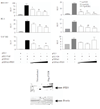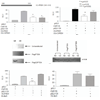Inhibition of U6 snRNA Transcription by PTEN
- PMID: 21479160
- PMCID: PMC3071578
- DOI: 10.3844/ojbsci.2010.114.125
Inhibition of U6 snRNA Transcription by PTEN
Abstract
PROBLEM STATEMENT: RNA polymerase III (RNA pol III) is responsible for transcribing many of the small structural RNA molecules involved in RNA processing and protein translation, thereby regulating the growth rate of a cell. RNA pol III transcribes both gene internal (tRNA) and gene external (U6 snRNA) promoters and proper initiation by RNA polymerase III requires the transcription initiation factor TFIIIB. TFIIIB has been shown to be a target of repression by tumor suppressors such as ARF, p53, RB and the RB-related pocket proteins. Also, TFIIIB activity is stimulated by the oncogenes c-Myc and the ERK mitogen-activated protein kinase. Recently, two TFIIIB subunits, BRF1 and BRF2, have been demonstrated to behave as oncogenes, making deregulation of TFIIIB activity and thus RNA pol III transcription an important step in tumor development. PTEN is a commonly mutated tumor suppressor regulating cell growth, proliferation and survival. Thus, we sought to examine the potential role of PTEN in regulating U6 snRNA transcription. APPROACH: We examined the potential for PTEN to regulate U6 snRNA transcription using in vitro RNA pol III luciferase assays, western blotting and deletion analysis in cancer cell lines differing in their PTEN status. RESULTS: Using breast, cervical, prostate and glioblastoma cancer cells we demonstrate: (1) PTEN inhibition of gene external RNA pol III transcription is cell type specific, (2) PTEN-mediated inhibition of U6 transcription occurs via the C2 lipid-binding domain and (3) PTEN repression of U6 transcription occurs, at least in part, through the TFIIIB subunit BRF2. CONCLUSION/RECOMMENDATIONS: Our data demonstrates that regulation of the U6 snRNA gene by PTEN is mediated, in part by the TFIIIB oncogene BRF2, potentially identifying novel targets for chemotherapeutic drug design.
Conflict of interest statement
Authors declare no conflict of interest.
Figures





References
-
- Bandyopadhyay S, Pai SK, Hirota S, Hosobe S, Tsukada T, et al. PTEN up-regulates the tumor metastasis suppressor gene Drg-1 in prostate and breast cancer. Cancer Res. 2004;64:7655–7660. - PubMed
-
- Chu WM, Wang Z, Roeder RB, Schmid CW. RNA polymerase III transcription repressed by Rb through its interactions with TFIIIB and TFIIIC2. J. Biol. Chem. 1997;272:14755–14761. - PubMed
-
- Chung JH, Ginn-Pease ME, Eng C. Phosphatase and tensin homologue deleted on chromosome 10 (PTEN) has nuclear localization signal-like sequences for nuclear import mediated by major vault protein. Cancer Res. 2005;65:4108–4116. - PubMed
Grants and funding
LinkOut - more resources
Full Text Sources
Research Materials
Miscellaneous
